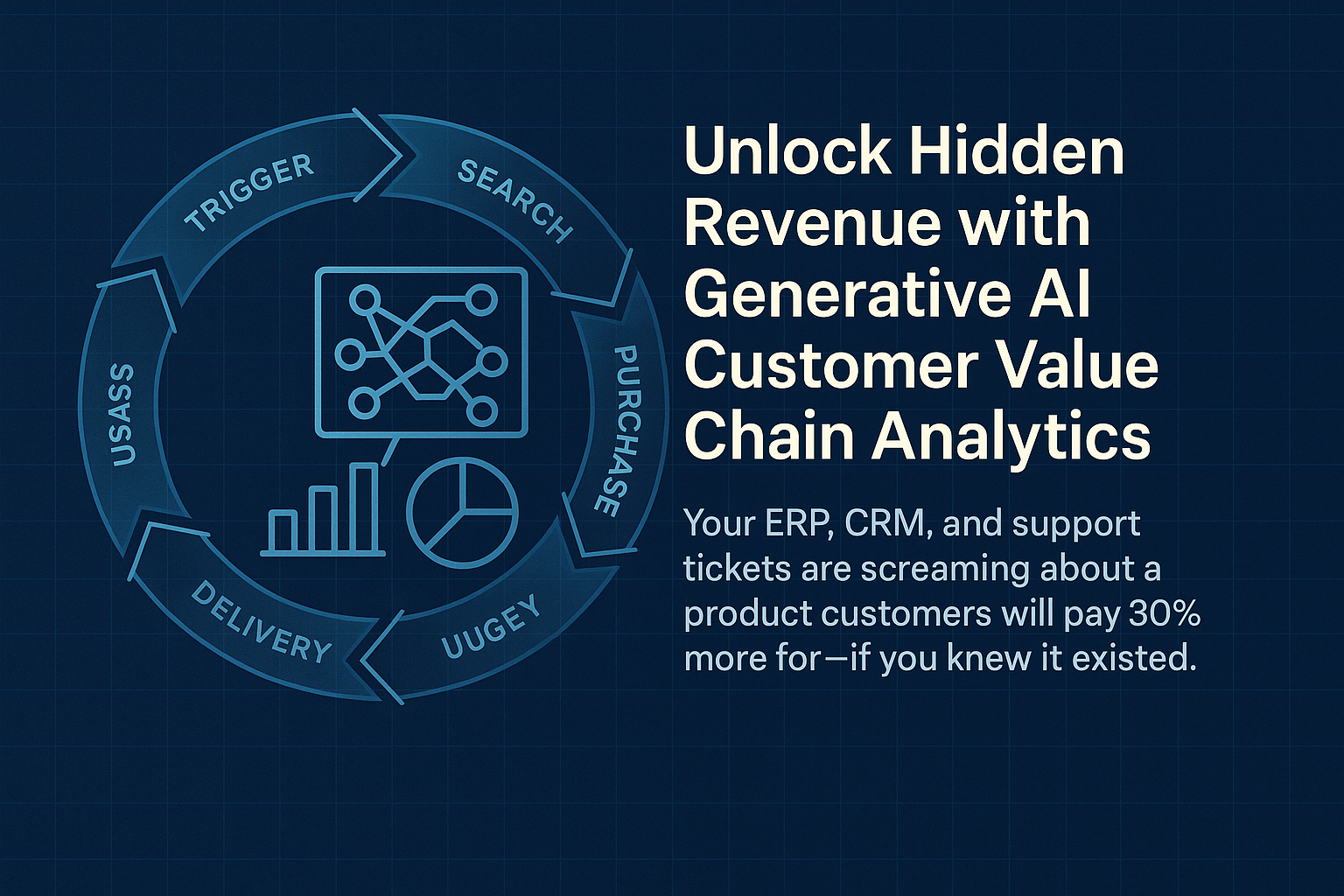In today’s fast-paced business environment, efficiency and growth are paramount. AI automation offers a powerful solution for achieving both. This article explores the significant return on investment (ROI) of AI Automation by examining the cost savings, time efficiencies, and revenue growth it can bring to various business operations.
Maximizing AI Automation ROI for business efficiency involves automating tasks such as data entry, inventory management, and customer relationship management. Automating data entry reduces errors and labor costs. Inventory management automation ensures optimal stock levels and reduces carrying costs. Automating customer relationship management enhances customer retention and drives sales. Implementing these automations results in substantial cost savings, increased revenue, and improved operational efficiency.
Before we dive into the details here are the key takeaways from this article:
Key Takeaways
- Automate Routine Tasks: Implement AI automation for tasks like data entry and invoice processing to achieve high cost savings and error reduction.
- Enhance Sales Processes: Use AI automation to streamline sales workflows and improve customer interactions, leading to increased revenue.
- Reallocate Resources: Free up human resources from routine tasks and reallocate them to strategic activities that drive innovation and growth.
- Measure and Maximize ROI: Identify key metrics, track performance with AI analytics tools, and continuously optimize your AI automation strategies.
- Realistic Implementation: Focus on key areas with the highest impact, such as data entry, sales processes, and HR tasks, for a phased approach to AI automation.
Let’s dive into each area to gain deeper insights into the ROI achieved through cost savings and revenue growth. Discover how AI automation can transform your business operations and deliver impressive results.
The Financial Impact of AI Automation
Automating routine tasks with AI can lead to significant financial benefits. By automating repetitive and time-consuming processes, businesses can save on labor costs and reduce human error. For example, data entry automation eliminates the need for manual input, reducing errors and freeing up employees to focus on more strategic tasks.
Specific Examples and Benefits of AI Automation in Routine Tasks
- Data Entry: Manual data entry is not only time-consuming but also prone to errors, which can be costly. By automating data entry, businesses can ensure accuracy and speed. For instance, a mid-sized financial services firm specializing in wealth management adopted AI for data entry across its client onboarding and reporting processes. The results were impressive:
- 60% reduction in operational costs related to data entry
- 95% decrease in data entry errors
- 40% faster client onboarding process
- Reallocation of 5 full-time employees to higher-value tasks
- Inventory Management: Traditional inventory management can be labor-intensive and inefficient. AI automation can track real-time inventory, predict stock needs based on sales data, and automatically reorder supplies. A retail company implemented AI-driven inventory management and reported a 30% decrease in inventory costs. This automation ensured optimal stock levels, reducing overstocking and stockouts and improving customer satisfaction.
- Invoice Processing: Handling invoices manually involves various steps, from data entry to approval processes, which can be slow and error-prone. AI can streamline invoice processing by automatically extracting information, validating data, and facilitating approvals. A manufacturing company that integrated AI for invoice processing reduced their invoice cycle time by 50% and cut processing costs by 40%. This efficiency also allowed their finance team to focus on more value-added activities, such as financial analysis and strategic planning.
- Customer Relationship Management (CRM): Automating CRM tasks helps manage customer interactions and data throughout the customer lifecycle efficiently. AI can automate tasks such as follow-up emails, appointment scheduling, and customer data updates. This not only saves time but also ensures that no customer engagement opportunities are missed. A technology services company reported a 25% increase in customer satisfaction scores and a 20% improvement in sales conversions after automating their CRM processes.
- Human Resources (HR): Routine HR tasks like resume screening, employee onboarding, and payroll processing can be automated to save time and reduce errors. AI-driven HR systems can quickly sift through resumes to identify the best candidates, automate onboarding processes to ensure compliance and manage payroll accurately. A healthcare provider that automated its HR processes saw a 25% reduction in HR-related costs and improved the overall employee experience, which led to higher employee retention rates.
Increasing Revenue with AI Automation
AI automation can directly contribute to revenue growth by streamlining sales processes and improving customer interactions. Automating sales workflows and using AI-driven analytics can help businesses identify high-potential leads, optimize pricing strategies, and personalize customer experiences.
Specific Examples and Benefits of AI Automation in Revenue Growth
- Lead Scoring and Follow-up: AI can analyze vast amounts of data to identify the most promising leads based on their behavior, demographics, and past interactions. Automating lead scoring ensures that sales teams focus their efforts on high-potential prospects. Additionally, automated follow-up emails can be tailored to the specific needs and interests of each lead, increasing the likelihood of conversion. For instance, a software company implemented AI to automate lead scoring and follow-up, resulting in a 20% increase in sales conversion rates. This approach not only improved efficiency but also enhanced the personalization of their sales outreach.
- Optimizing Pricing Strategies: AI-driven analytics can help businesses determine the optimal pricing for their products or services by analyzing market trends, competitor pricing, and customer behavior. Dynamic pricing models, powered by AI, allow companies to adjust prices in real-time based on demand and other factors, maximizing revenue. A retail company used AI to optimize their pricing strategy, which led to a 15% increase in overall sales. This automation ensured they remained competitive while maximizing profitability.
- Personalizing Customer Experiences: AI can personalize customer interactions by analyzing data to understand individual preferences and behaviors. This enables businesses to offer personalized product recommendations, targeted marketing campaigns, and tailored customer service. An e-commerce business that implemented AI for personalization saw a 15% increase in repeat purchases. By automating personalized recommendations and marketing messages, they enhanced customer satisfaction and loyalty, driving higher sales.
- Automating Sales Workflows: Sales processes often involve repetitive tasks such as data entry, appointment scheduling, and follow-up communications. AI automation can streamline these workflows, allowing sales teams to focus on building relationships and closing deals. A technology services firm automated its sales workflow, which included lead generation, follow-up emails, and meeting scheduling. This automation reduced administrative tasks by 40% and enabled their sales team to increase their client base significantly.
- Enhancing Customer Service with AI Chatbots: AI chatbots can handle customer inquiries 24/7, providing instant support and freeing up human agents to handle more complex issues. This not only improves response times but also enhances customer satisfaction. An e-commerce business integrated AI chatbots into their customer service strategy, resulting in a 15% increase in repeat purchases and improved customer retention rates. The chatbots provided quick and accurate responses to common queries, while human agents focused on personalized customer support.
Case Studies of Revenue Growth
- Sales Processes: A software company increased its sales conversion rate by 20% by automating lead scoring and follow-up emails, ensuring timely and relevant communication with prospects. This resulted in a more efficient sales process and higher revenue.
- Customer Interactions: Automating customer service with AI chatbots can enhance customer satisfaction and retention. An e-commerce business saw a 15% increase in repeat purchases after implementing AI chatbots for customer support. The automation allowed for quick and accurate responses, improving the overall customer experience.
Improving Operational Efficiency with AI Automation
AI automation not only saves money but also enhances overall operational efficiency. By automating back-office functions and real-time data processing, businesses can streamline their operations and make more informed decisions. For example, automating HR tasks such as resume screening and payroll processing reduces administrative burdens and ensures compliance. A healthcare provider that automated its HR processes saw a 25% reduction in HR-related costs and improved employee satisfaction.
In finance and accounting, AI can handle routine tasks like invoice processing and financial reporting, leading to faster and more accurate results. A logistics company that implemented AI for financial reporting reduced reporting time by 40%, allowing their finance team to focus on strategic planning. Similarly, supply chain management benefits from AI automation through improved demand forecasting and inventory management. A manufacturing company using AI for supply chain automation achieved a 25% reduction in holding costs and a 15% improvement in delivery times.
Real-time data processing is another area where AI automation shines, providing actionable insights and enabling quicker decision-making. For instance, an e-commerce platform used AI to analyze customer data in real-time, resulting in a 20% increase in sales during peak periods. These examples illustrate how AI automation can significantly enhance operational efficiency by streamlining processes and improving accuracy, ultimately optimizing business performance.
Leveraging AI Automation to Reallocate Resources
AI automation not only saves money but also enhances overall operational efficiency, benefiting your team by freeing them from routine tasks. By automating repetitive processes, businesses can reallocate human resources to more strategic and value-added activities. This shift allows employees to focus on tasks that require creativity, problem-solving, and strategic thinking, driving innovation and growth within the company.
Reallocating Resources for Greater Impact
- Human Resources (HR): Automating HR tasks such as recruitment, onboarding, and payroll processing not only reduces administrative burdens but also allows HR professionals to focus on more impactful activities. Instead of spending time on repetitive data entry and compliance checks, HR teams can dedicate their efforts to employee development, training programs, and fostering a positive workplace culture. This reallocation can lead to improved employee satisfaction and retention, as well as a more engaged and productive workforce.
- Finance: AI automation in finance can handle routine tasks such as invoice processing, expense management, and financial reporting. By automating these functions, finance professionals can shift their focus to strategic financial planning, analysis, and decision-making. This enables the finance team to provide more insightful financial guidance and support to the business, helping to drive growth and profitability. For instance, a logistics company that automated their financial reporting reduced reporting time by 40%, allowing their finance team to concentrate on growth initiatives and strategic decision-making.
- Operations: In operations, AI automation can streamline processes such as inventory management, supply chain coordination, and production scheduling. With routine tasks automated, operations managers can focus on optimizing workflows, improving process efficiency, and developing innovative solutions to operational challenges. This shift not only enhances overall operational performance but also positions the company to better respond to market demands and changes.
Maximizing AI Automation ROI
Understanding and maximizing AI automation ROI involves strategic planning and continuous optimization. Implementing AI automation across various business functions can lead to substantial savings and increased profits.
Potential Savings and Profit Increases
By fully implementing AI automation in data entry, inventory management, sales processes, customer interactions, and back-office functions, businesses can achieve remarkable financial results. Here’s a summary of the potential benefits:
- Cost Savings: Businesses can save up to 60-70% on operational costs by automating routine tasks such as data entry and invoice processing. This results from reduced labor costs, minimized errors, and faster processing times.
- Revenue Growth: Automating sales workflows and customer interactions can lead to a 15-20% increase in revenue. AI-driven analytics and personalized customer experiences enhance conversion rates and customer loyalty.
- Efficiency Gains: Streamlining back-office functions like HR and finance can reduce administrative burdens and reporting times by 25-40%. This allows teams to focus on strategic initiatives, driving overall business growth.
- Resource Optimization: By reallocating human resources to more strategic tasks, companies can drive innovation and improve employee satisfaction and retention.
Top Recommendations for Realistic Implementation
For businesses looking to take a more gradual approach, focusing on key areas with the highest impact can still yield significant benefits. Here are the top three recommendations:
- Automate Data Entry and Invoice Processing:
- Impact: High cost savings and error reduction.
- Example: A financial services firm saw a 60% reduction in operational costs by automating data entry, and a manufacturing company reduced invoice processing time by 50%.
- Enhance Sales Workflows with AI Automation:
- Impact: Increased revenue and improved customer interactions.
- Example: A software company increased its sales conversion rate by 20% through automated lead scoring and follow-up emails.
- Streamline HR Processes:
- Impact: Reduced administrative burden and improved employee satisfaction.
- Example: A healthcare provider saw a 25% reduction in HR-related costs and improved employee satisfaction through automation.
Strategies for Measuring and Maximizing ROI
Maximizing the return on investment (ROI) from AI automation requires a strategic approach that includes identifying key metrics, tracking performance, and continuous optimization. Here’s a more detailed look at how businesses can effectively measure and maximize their AI automation ROI.
Identify Key Metrics
Determining the most relevant metrics is the first step in measuring AI automation ROI. Key metrics will vary depending on the specific goals and processes being automated but generally include:
- Cost Savings: Measure the reduction in operational costs achieved through automation. This includes savings from reduced labor costs, minimized errors, and decreased material waste.
- Time Savings: Evaluate the time saved by automating tasks that were previously manual. This metric is crucial for understanding the efficiency gains and how much more productive the workforce can be.
- Error Reduction: Track the decrease in errors and the associated costs. Reducing errors can lead to significant savings, especially in areas like data entry and financial reporting.
- Revenue Growth: Monitor the increase in revenue generated through enhanced sales processes and improved customer interactions. This metric helps quantify the direct financial benefits of AI automation.
- Employee Productivity and Satisfaction: Assess how automation impacts employee morale and productivity. Higher job satisfaction and efficiency often translate to better overall business performance.
Track Performance
Utilizing AI analytics tools is essential for monitoring the performance of automated processes. These tools provide real-time insights and data-driven feedback, enabling businesses to optimize their AI automation ROI. Here are some recommended approaches and tools:
- Implement AI-powered dashboards: Use tools like Tableau or Power BI to create custom dashboards that visualize key performance metrics in real-time.
- Utilize process mining software: Tools like Celonis or UiPath Process Mining can help identify bottlenecks and inefficiencies in your automated processes.
- Leverage predictive analytics: Platforms like DataRobot or H2O.ai can help forecast future performance and identify areas for improvement.
- Set up automated alerts: Configure your analytics tools to send notifications when key metrics deviate from expected ranges, allowing for quick interventions.
- Conduct regular A/B testing: Use tools like Optimizely or Google Optimize to test different automation strategies and identify the most effective approaches.
Continuous Optimization
AI automation is not a one-time implementation but an ongoing process that requires regular review and refinement to maximize ROI. Continuous optimization involves:
- Regular Performance Reviews: Conduct periodic reviews of the automated processes to assess their effectiveness. Gather feedback from employees who interact with the automated systems to identify areas for improvement.
- Adapt to Changing Business Needs: As business goals and market conditions evolve, ensure that your AI automation strategies are flexible and can adapt to these changes. This might involve scaling up automation in certain areas or integrating new AI technologies.
- Invest in Training and Development: Equip your team with the necessary skills to manage and optimize AI systems. Regular training ensures that employees can effectively interact with and leverage AI automation tools.
- Iterative Improvements: Implement a cycle of continuous improvements based on the insights gathered from performance tracking. Small, incremental changes can lead to significant improvements over time.
- Leverage Advanced AI Features: Stay updated with the latest advancements in AI technology and incorporate new features that can enhance your automation efforts. This can include predictive analytics, machine learning algorithms, and natural language processing capabilities.
Transform Your Business with AI Automation
AI automation offers significant ROI through cost savings, increased revenue, and improved operational efficiency. Businesses can achieve remarkable results and gain a competitive advantage in today’s fast-paced market by strategically implementing and optimizing AI automation. The key to success lies in a thoughtful approach to implementation, continuous performance monitoring, and a willingness to adapt to emerging trends in AI technology.
Ready to unlock the full potential of AI automation for your business? Inkyma specializes in tailoring AI automation solutions to meet your unique business needs. Our team of experts can guide you through every step of the process, from initial assessment to implementation and ongoing optimization. Don’t let your competitors get ahead – schedule a free AI Automation ROI strategy session with Inkyma today and discover how we can help you achieve up to 60% cost savings and 20% revenue growth through strategic AI automation.
What initial steps should a business take to begin implementing AI automation to maximize ROI?
To begin implementing AI automation and maximize ROI, businesses should start with a thorough assessment of their current processes to identify tasks that are repetitive and time-consuming. Next, they should set clear objectives for what they hope to achieve with AI automation ROI, such as cost savings, increased efficiency, or improved accuracy. It’s important to choose the right AI tools and platforms that align with these goals. Finally, businesses should pilot the automation on a small scale to test its effectiveness before scaling up.
How can AI automation impact customer satisfaction and contribute to AI Automation ROI?
AI automation can significantly enhance customer satisfaction by providing faster and more accurate responses to customer inquiries, which contributes to AI Automation ROI. Automated systems like chatbots handle customer service queries 24/7, reducing wait times and ensuring customers receive immediate assistance. Additionally, AI can personalize customer interactions based on data analysis, offering tailored recommendations and solutions that meet individual needs. This leads to a more positive customer experience and higher satisfaction levels, ultimately driving increased revenue and ROI.
What are the potential challenges businesses might face when implementing AI automation, and how do they affect AI Automation ROI?
Businesses might face several challenges when implementing AI automation, which can impact AI Automation ROI. These include resistance to change from employees, high initial setup costs, and the need for ongoing maintenance and updates. There may also be a learning curve associated with new technologies, requiring training and support for staff. Additionally, ensuring data privacy and security can be a significant concern, as automated systems often handle sensitive information. Addressing these challenges requires careful planning, clear communication, and a strategic approach to implementation to ensure the desired ROI is achieved.












